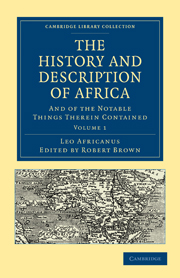Book contents
- Frontmatter
- Contents
- PREFATORY NOTE
- INTRODUCTION
- NORTHERN AFRICA
- BARBARY
- NORTHERN FEZ
- PORY'S MAP OF AFRICA (reduced)
- A GEOGRAPHICAL HISTORIE of AFRICA
- PORY'S DEDICATION TO SIR ROBERT CECIL
- HIS ADDRESS TO THE READER
- HIS GENERAL DESCRIPTION OF AFRICA
- HIS DESCRIPTION OF PLACES UNDESCRIBED BY LEO
- AN APPROBATION OF LEO'S HISTORY BY RICHARD HAKLUYT AND OTHERS
- Notes on Pory's Introductory Matter
- JOHN LEO HIS FIRST BOOK OF THE DESCRIPTION OF AFRICA
- Notes to Book I
INTRODUCTION
Published online by Cambridge University Press: 05 October 2010
- Frontmatter
- Contents
- PREFATORY NOTE
- INTRODUCTION
- NORTHERN AFRICA
- BARBARY
- NORTHERN FEZ
- PORY'S MAP OF AFRICA (reduced)
- A GEOGRAPHICAL HISTORIE of AFRICA
- PORY'S DEDICATION TO SIR ROBERT CECIL
- HIS ADDRESS TO THE READER
- HIS GENERAL DESCRIPTION OF AFRICA
- HIS DESCRIPTION OF PLACES UNDESCRIBED BY LEO
- AN APPROBATION OF LEO'S HISTORY BY RICHARD HAKLUYT AND OTHERS
- Notes on Pory's Introductory Matter
- JOHN LEO HIS FIRST BOOK OF THE DESCRIPTION OF AFRICA
- Notes to Book I
Summary
The Arab who wrote the famous work to which these pages form an Introduction bears many names. That by which he was first introduced to the knowledge of lettered Europe by Gian Battista Ramusio (1485-1557), Secretary of the Venetian Council of Ten, was Giovanni Leone or Leo. This name he received from Giovanni de' Medici, Pope Leo X, who was first his master, then the priest by whom he was converted to Christianity, and finally his godfather and patron. Hence Leo is also sometimes known as Joannes Medices. Having been born in Granada he is occasionally termed Eliberitances–Granada being falsely supposed to be the Roman Illiberes. However, from the fact of Leo being an African, or from his writing on Africa, he is now invariably called Leo Africanus.
His Arab name was Al-Hassan Ibn Mohammed Al-Wezâz, Al-Fâsi, that is, the man of Fez (a surname he obtained in his later years). He is also known as “El-Gharnâthi”, the Granadian, a designation which, apart from other facts, renders it extremely probable that he was born, not in Morocco, as “Al-Fâsi” might seem to indicate, but in Granada. On this point, indeed, there can be little doubt: for not only does he state the circumstance more than once in the body of the volume, but Ramusio, who obtained his information from one of Leo's friends, reiterates the statement.
- Type
- Chapter
- Information
- The History and Description of AfricaAnd of the Notable Things Therein Contained, pp. ix - cxiPublisher: Cambridge University PressPrint publication year: 2010First published in: 1896



